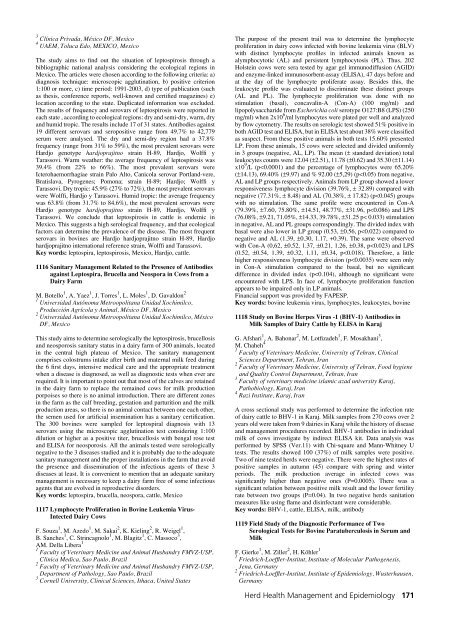Oral and Poster Abstracts
Oral and Poster Abstracts
Oral and Poster Abstracts
You also want an ePaper? Increase the reach of your titles
YUMPU automatically turns print PDFs into web optimized ePapers that Google loves.
3 Clínica Privada, México DF, Mexico<br />
4 UAEM, Toluca Edo, MEXICO, Mexico<br />
The study aims to find out the situation of leptospirosis through a<br />
bibliographic national analysis considering the ecological regions in<br />
Mexico. The articles were chosen according to the following criteria: a)<br />
diagnosis technique: microscopic agglutination, b) positive criterion<br />
1:100 or more, c) time period: 1991-2003, d) type of publication (such<br />
as thesis, conference reports, well-known <strong>and</strong> certified magazines) e)<br />
location according to the state. Duplicated information was excluded.<br />
The results of frequency <strong>and</strong> serovars of leptospirosis were reported in<br />
each state , according to ecological regions: dry <strong>and</strong> semi-dry, warm, dry<br />
<strong>and</strong> humid tropic. The results include 17 of 31 states. Antibodies against<br />
19 different serovars <strong>and</strong> seropositive range from 49.7% to 42,779<br />
serum were analysed. The dry <strong>and</strong> semi-dry region had a 37.8%<br />
frequency (range from 31% to 59%), the most prevalent serovars were<br />
Hardjo genotype hardjoprajitno strain H-89, Hardjo, Wolffi y<br />
Tarassovi. Warm weather: the average frequency of leptospirosis was<br />
39.4% (from 22% to 66%). The most prevalent serovars were<br />
Icterohaemorrhagiae strain Palo Alto, Canicola serovar Portl<strong>and</strong>-vere,<br />
Bratislava, Pyrogenes; Pomona; strain H-89; Hardjo; Wolffi y<br />
Tarassovi. Dry tropic: 45.9% (27% to 72%), the most prevalent serovars<br />
were Wolffi, Hardjo y Tarassovi. Humid tropic: the average frequency<br />
was 63.8% (from 31.7% to 84.6%), the most prevalent serovars were<br />
Hardjo genotype hardjoprajitno strain H-89, Hardjo, Wolffi y<br />
Tarassovi. We conclude that leptospirosis in cattle is endemic in<br />
Mexico. This suggests a high serological frequency, <strong>and</strong> that ecological<br />
factors can determine the prevalence of the disease. The most frequent<br />
serovars in bovines are Hardjo hardjoprajitno strain H-89, Hardjo<br />
hardjoprajitno international reference strain, Wolffi <strong>and</strong> Tarassovi.<br />
Key words: leptospira, leptospirosis, Mexico, Hardjo, cattle.<br />
1116 Sanitary Management Related to the Presence of Antibodies<br />
against Leptospira, Brucella <strong>and</strong> Neospora in Cows from a<br />
Dairy Farm<br />
M. Botello 1 , A. Yaez 1 , J. Torres 1 , L. Moles 1 , D. Gavaldon 2<br />
1<br />
Universidad Autónoma Metroopolitana Unidad Xochimilco,<br />
Producción Agrícola y Animal, México DF, Mexico<br />
2<br />
Universidad Autónoma Metroopolitana Unidad Xochimilco, México<br />
DF, Mexico<br />
This study aims to determine serologically the leptospirosis, brucellosis<br />
<strong>and</strong> neosporosis sanitary status in a dairy farm of 300 animals, located<br />
in the central high plateau of Mexico. The sanitary management<br />
comprises colostrums intake after birth <strong>and</strong> maternal milk feed during<br />
the 6 first days, intensive medical care <strong>and</strong> the appropriate treatment<br />
when a disease is diagnosed, as well as diagnostic tests when ever are<br />
required. It is important to point out that most of the calves are retained<br />
in the dairy farm to replace the remained cows for milk production<br />
porpoises so there is no animal introduction. There are different zones<br />
in the farm as the calf breeding, gestation <strong>and</strong> parturition <strong>and</strong> the milk<br />
production areas, so there is no animal contact between one each other,<br />
the semen used for artificial insemination has a sanitary certification.<br />
The 300 bovines were sampled for leptospiral diagnosis with 13<br />
serovars using the microscopic agglutination test considering 1:100<br />
dilution or higher as a positive titer, brucellosis with bengal rose test<br />
<strong>and</strong> ELISA for neosporosis. All the animals tested were serologically<br />
negative to the 3 diseases studied <strong>and</strong> it is probably due to the adequate<br />
sanitary management <strong>and</strong> the proper installations in the farm that avoid<br />
the presence <strong>and</strong> dissemination of the infectious agents of these 3<br />
diseases at least. It is convenient to mention that an adequate sanitary<br />
management is necessary to keep a dairy farm free of some infectious<br />
agents that are evolved in reproductive disorders.<br />
Key words: leptospira, brucella, neospora, cattle, Mexico<br />
1117 Lymphocyte Proliferation in Bovine Leukemia Virus-<br />
Intected Dairy Cows<br />
F. Souza 1 , M. Azedo 1 , M. Sakai 2 , K. Kieling 2 , R. Weigel 1 ,<br />
B. Sanches 1 , C. Strincagnolo 1 , M. Blagitz 1 , C. Massoco 3 ,<br />
AM. Della Libera 1<br />
1 Faculty of Veterinary Medicine <strong>and</strong> Animal Husb<strong>and</strong>ry FMVZ-USP,<br />
Clinica Medica, Sao Paulo, Brazil<br />
2 Faculty of Veterinary Medicine <strong>and</strong> Animal Husb<strong>and</strong>ry FMVZ-USP,<br />
Department of Pathology, Sao Paulo, Brazil<br />
3 Cornell University, Clinical Sciences, Ithaca, United States<br />
The purpose of the present trail was to determine the lymphocyte<br />
proliferation in dairy cows infected with bovine leukemia virus (BLV)<br />
with distinct lymphocyte profiles in infected animals known as<br />
alymphocytotic (AL) <strong>and</strong> persistent lymphocytosis (PL). Thus, 202<br />
Holstein cows were sera tested by agar gel immunodiffusion (AGID)<br />
<strong>and</strong> enzyme-linked immunosorbent-assay (ELISA), 47 days before <strong>and</strong><br />
at the day of the lymphocyte proliferate assay. Besides this, the<br />
leukocyte profile was evaluated to discriminate these distinct groups<br />
(AL <strong>and</strong> PL). The lymphocyte proliferation was done with no<br />
stimulation (basal), concavalin-A (Con-A) (100 mg/ml) <strong>and</strong><br />
lipopolysaccharide from Escherichia coli serotype O127:B8 (LPS) (250<br />
mg/ml) when 2x10 6 /ml lymphocytes were plated per well <strong>and</strong> analyzed<br />
by flow cytometry. The results on serologic test showed 51% positive in<br />
both AGID test <strong>and</strong> ELISA, but in ELISA test about 38% were classified<br />
as suspect. From these positive animals in both tests 15.60% presented<br />
LP. From these animals, 15 cows were selected <strong>and</strong> divided uniformly<br />
in 3 groups (negative, AL, LP). The mean (± st<strong>and</strong>ard deviation) total<br />
leukocytes counts were 12.04 (±2.51), 11.78 (±0.62) <strong>and</strong> 35.30 (±11.14)<br />
x10 9 /L (p

















